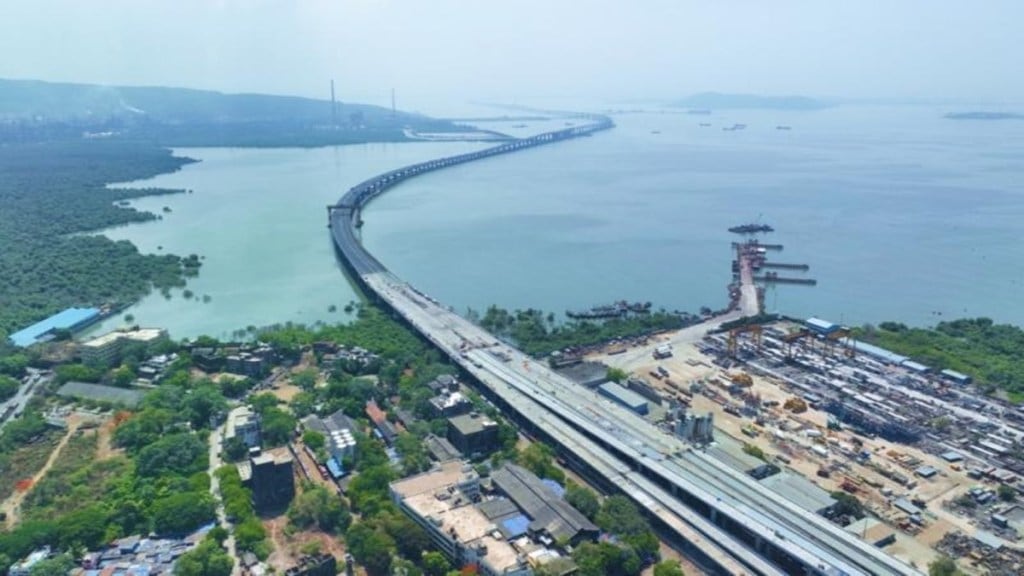Sanjay Dutt, managing director of Tata Realty & Infrastructure, is looking forward to Friday (tomorrow) when Prime Minister Narendra Modi inaugurates the 21.8-km Mumbai Trans Harbour Link (MTHL), which will connect Sewri in South Mumbai to Chirle near Navi Mumbai.
“I am really looking forward to drive on it in a pollution-free environment when I travel to other side of the city,” Dutt says about the project that will see Mumbai taking another giant step towards better road connectivity. Besides lane driving and wider roads, absence of traffic jams should be the icing on the cake, Dutt adds.
He is among thousands of Mumbaikars who are waiting eagerly for the D-day to arrive. “It is a proud moment for each and every Mumbaikar who will save hours of commute while driving on the nation’s longest sea bridge,” says Gautam Hari Singhania, chairman and managing director of Raymond.
Officially called the “Atal Bihari Vajpayee Sewri-Nhava Sheva Atal Setu”, it will cut travel time between the two nodes from two-and-a-half hours to just 20 minutes. It is estimated that 10 million litres of fuel will be saved annually.
The engineering marvel costing Rs 17,843 crore has many unique features – about16.5 km of the stretch is on sea and 5.5 km on land. The speed limit will be 100 km per hour (a dream for most Mumbaikars), cameras every 330 metres, noise barriers in the first 4 km, and view barriers for added security, commuters have a lot to watch out for, too. After the initial 10 kms, commuters can enjoy stunning views of Mumbai’s skyline and the Elephanta Caves.
Mumbai Metropolitan Development Authority (MMRDA) has estimated that 70,000 vehicles will use the link every day. The six-lane link has been divided into three construction parts comprising 10.38 km developed by L&T-IHI consortium, 7.807 km by Daewoo-Tata JV and 3.6 km by L&T.
For obvious reasons, the developers of the link are proud about what they have created. “We have brought the cities of Mumbai and Navi Mumbai closer, boosting economic growth, reducing carbon footprint and, most importantly, easing the traffic woes of Mumbaikars,” says SV Desai, whole time director & senior executive vice president (civil Infrastructure) at L&T.
MTHL, he said, is a modern engineering marvel with several first-of-its-kind technical features and complex marine challenges. “Logistical challenges tested the skill and resilience of every engineer, and stakeholder involved,” Desai says, adding care has been taken to maintain the pristine habitat of the flamingos and other marine flora and fauna and preserving the marine ecosystem.
The only spoiler, however, is the high toll charges. Initially, MMRDA had proposed a toll of Rs 500, which was later slashed to Rs 350 by the urban development department. Later, the state cabinet reduced it to Rs 250.
Growth engine
Many such as Keshav R Murugesh, Group CEO, WNS Global Services believes “the ambitious infrastructure project holds immense promise to redefine connectivity between Maharashtra’s largest commercial hubs, by more than halving the travel time. The link will give an impetus to the state’s business growth, opening opportunities for trade, commerce and investment, as well as generating employment for the youth, he adds.
Niranjan Hiranadani, managing director of Hiranandani group, says the link will throw up land parcels on the other side of the city (near Navi Mumbai) which is half the size of Mumbai. “Developers can develop a lot of new projects there now,” Hiranandani says, adding that Navi Mumbai Airport, Naina (Navi Mumbai Airport Influence Notified Area) and others will be half an hour from the main land.
Dutt of Tata Realty adds that the link will reduce the price gap between Navi Mumbai and South Mumbai. “A similar thing happened when Bandra Worli Sea Link was opened. The price gap between South Mumbai and Bandra reduced,” he says. The link is expected to increase prices of new locations near Navi Mumbai.
Vimal Nadar, senior director, research at Colliers India, says areas under the influence zone of the project corridor, including Sewri, Chirle, Ulwe, Kalamboli and Panvel, will see plethora of real estate opportunities across asset classes. All such relatively dormant localities are set to embark upon a high real estate growth trajectory sooner rather than later, providing lucrative investment options within MMR.
Once operational, MTHL will also be pivotal in connecting the data centre hotspots within Navi Mumbai to rest of the MMR.
Infra boost
Hiranandani says with MTHL, 300 kms of Metro tracks and new airport, Mumbai’s infrastructure is set to get a major makeover in the next two years. Dutt of Tata Realty adds that given the size of the MMR population of 20 million, the infrastructure development would certainly help.
Others agree. With the development of Nhava Sheva port, more than passenger movement, cargo movement would be much better, says renowned architect Shashi Prabhu as “the port will now be closer to the city”. So, come Friday, get ready for Mumbai Next.

